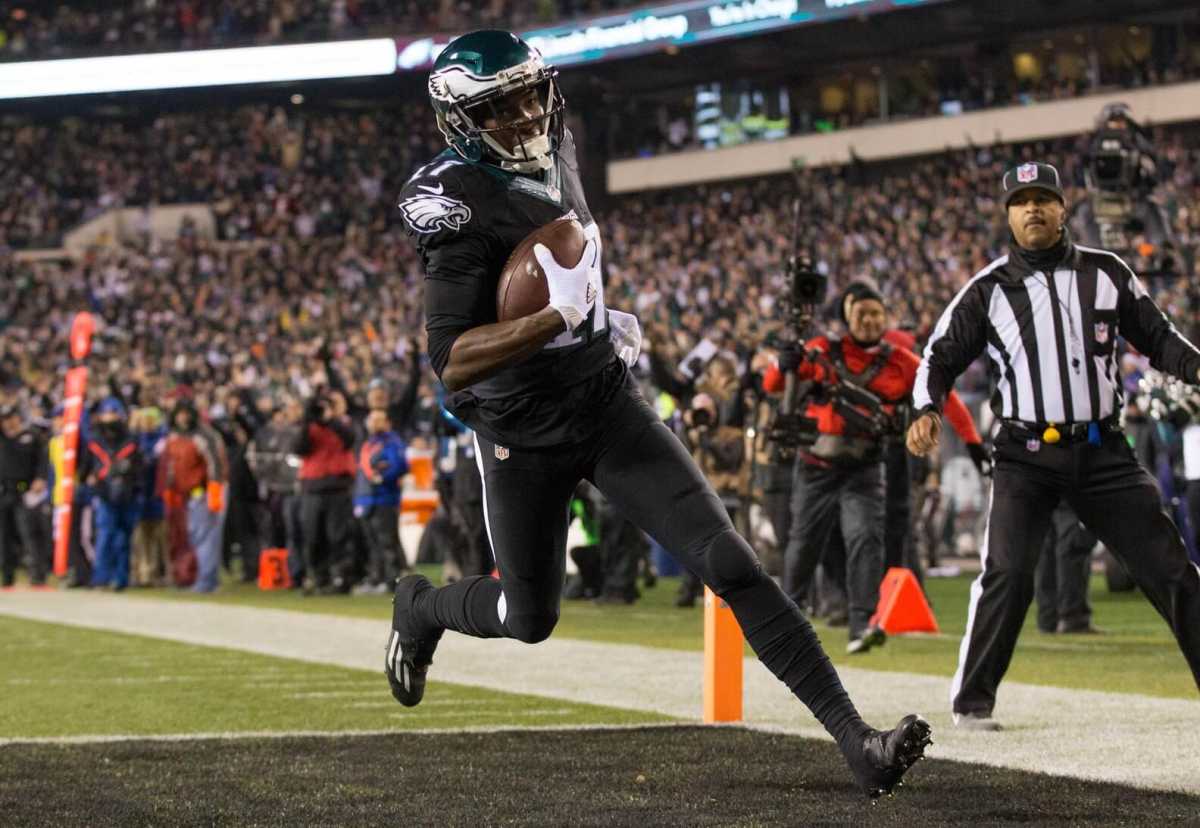The 2016 season was a transitional one for the Philadelphia Eagles on both sides of the ball. A rookie Head Coach was tasked with coaching a rookie quarterback and bringing his own offensive scheme to the table, while on Defense it was Jim Schwartz who set the tone. Pederson’s Offense was inconsistent at best during his first year, while the Jim Schwartz Defense emerged as a top unit in the earlier weeks of the season before dropping off as the year drew on. While both coaches and units had completely different season’s, there is one thing they both have in common. A lack of speed.
Doug Pederson’s Offense appeared to be fairly limited in the opening weeks and Carson Wentz rarely threw the ball down the field. If we exclude the Darren Sproles TD against the Steelers, it wasn’t until week 5 that the North Dakota State product had a longest pass of over 50 yards, earning him and Pederson a “Dink-and-dunk” reputation. Many assumed that this was due to the playcalling limitations of a Head Coach in his first year, still trying to find his feet. But if you scratch beneath the surface, it may be that the Eagles simply didn’t have the speed needed to complete some of the more complex and deeper routes.
The intimidate routes suffered as well however. Kick return ace, Josh Huff found his niche in Pederson’s scheme during preseason after an underwhelming training camp. Jet sweeps and screen passes looked set to take on a more prominent role and become a window of opportunity for Huff. In the opening weeks of the season, the former Eagle recorded 63 yards, most of which were on these routes, After his off-the-field behavior forced the Eagles to release the speedster, the Offense simply lacked that dynamic.
The team tried to use Nelson Agholor in the same role, but to no avail. Agholor’s lack of burst made it incredibly difficult for him to gain momentum, while his decision making and lack of experience in the role saw him try to do too much with the ball, missing huge holes and easy cuts, instead driving for the sideline.
The trend carried throughout the WR and TE positions..as the Eagles try to expand their playbook, they were often limited without a perennial deep threat or those game-changing plays built on speed. The receiving corps are all very close when it comes to the 40-yard dash, with the exception of one man.
It wasn’t until Bryce Treggs was added to the 53-man roster that the Offense began to take on a more experimental guise. Treggs caught a 58-yard bomb on his debut and the Eagles began to take a lot more shots down the field. That was also the case when Zach Ertz returned to the field after missing several games due to injury. With Jordan Matthews being the stand-alone receiving threat for the Eagles, if he was taken out of the game and there was no Zach Ertz to turn to, the birds struggled to move the ball down the field with ease.
Even when Ertz was on the field, it was rare to see a big play. The Stanford star began to pick up momentum in the final games of the season, but breaking tackles and turning on the afterburners has always been something that has alluded Ertz. Third string TE Trey Burton on the other hand, tapped into his WR skill set utilized at Florida and was able to average 8.8 yards per reception in 2016. Not only that, but he recorded 135 YAC, averaging a narrow 0.1 yards more per reception than Ertz. The speed and athleticism of Trey Burton helped in areas where Ertz struggled, be it due to injury or overall ceiling. But because of last offseason’s extensions, it was Ertz who was targeted 106 times..not Burton.
On Defense, there was a vicious cycle that began to reveal itself as the season progressed. Brandon Graham has blistering speed on the outside and as a result, he thrived in the aggressive Jim Schwartz system. Beyond Graham however, the speed was rare to see. Connor Barwin and Vinny Curry struggled to execute at times while Marcus Smith showed his potential to develop into a strong run stopper. But the other traits of the Eagles edge rushers; the aggression, technique, instincts and strength made up for a lack of outright speed in many of those situations….until something happened.
The Eagles Defense established a reputation as one of the most rampant in the league. The pass rush was racking up sacks, and fumbles while opposing offenses were simply stifled when trying to run the ball. So what did upcoming opponents do to combat this? Get the ball out quicker. Now this wouldn’t be a problem if the Eagles lack of speed didn’t spread to the secondary..but it did.
Without Ron Brooks, the Eagles were left with Nolan Carroll, Leodis McKelvin and seventh round draft pick, Jalen Mills. Carroll and McKelvin battled injury throughout the year, placing even more pressure on Mills, who is predominantly a cornerback who wins later in the route.

The trio struggled from the very first snap of the season until the very last at winning the battle on the line of scrimmage. An inability to jam, poor decisions and sloppy footwork often left the corners at a disadvantage and they don’t have the speed to recover against some of the faster receivers in the league. Offenses began scheming more routes over the middle, knowing that a quick step is all it took for their guys outside to gain more than enough separation.
If Offenses are getting the ball out quicker, a pass rush lacking speed as it is has a much tougher job of getting to the quarterback..and if the cornerbacks lack speed to recover from their notorious problems early in the route, it means that teams can simply move the ball at will against the Eagles.
The linebackers are a prime example of why speed matters. Jordan Hicks put the unit on his back this year, building upon his rookie season with a stunning second season in the NFL. Hicks was often cleaning up alongside Nigel Bradham and Safety Rodney McLeod. The trio were three of the most vital cogs on the Eagles Defense in 2016. Mychal Kendricks on the other hand, who struggles in coverage failed to show enough to secure a starting role in the preseason. Instead, he was forced to play in the preseason finale before the Eagles decided on adapting a nickel look more often than not.
Kendricks spent most of 2016 on the sidelines alongside Stephen Tulloch..but there was one instance in which the Eagles decided to try something different. Nigel Bradham was facing his second court-case of the year and the Eagles decided to take action by keeping him sidelined in the opening drives against the Lions. The result was two touchdowns in the Lions first two drives.
It doesn’t matter whether it’s skill positions, pass rushers or even Offensive linemen (a place where they thrive athletically), speed matters..and a lack of it hurt the Eagles massively in 2016. It’s easy to see why many pine for the return of DeSean Jackson or want to see the Eagles focus on stretching the field.
As much as Doug Pederson was forced to mature at a rate he probably didn’t expect in 2016, his Offense was limited not just because of the Head Coach, but because the team didn’t have the burst, acceleration or speed to take the top off of a Defense or stop a very smart Offense from taking full advantage of this weakness.
Mandatory Credit: Bill Streicher-USA TODAY Sports


























